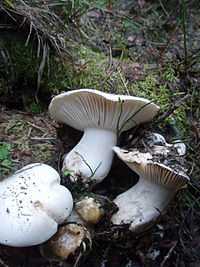Hygrophorus subalpinus
| Hygrophorus subalpinus | |
|---|---|
 | |
| Scientific classification | |
| Kingdom: | Fungi |
| Division: | Basidiomycota |
| Class: | Agaricomycetes |
| Order: | Agaricales |
| Family: | Hygrophoraceae |
| Genus: | Hygrophorus |
| Species: | H. subalpinus |
| Binomial name | |
| Hygrophorus subalpinus A.H. Sm. | |
Hygrophorus subalpinus, commonly known as the subalpine waxycap,[1] is a species of fungus in the family Hygrophoraceae. Found in the mountains of western North America, it is found growing on the ground under conifers, usually near snowbanks.
Description
The cap of H. subalpinus is typically 4 to 6 cm (1.6 to 2.4 in) in diameter, with a convex shape that becomes flattened in age; sometimes it develops a central umbo (a rounded elevation resembling a nipple). The cap is sticky, white, and the cap margin often has fragments of the veil adhering. The flesh is soft, thick and white. The gills, which are attached decurrently to the stem (running down the length of the stem), are narrow, packed closely together, and white-colored. The stem is white, 3 to 4 centimetres (1.2 to 1.6 in) long and 1 to 2 cm (0.4 to 0.8 in) thick at the apex; when young the base of the stem is bulbous but as it grows it thins and becomes almost the same width as at the top of the stem. A membranous annulus is present, placed low on the stem.
Microscopic characteristics
The spores are white in deposit; microscopically, they are ellipsoid and smooth, with dimensions of 8–10 by 4.5–5 µm.[2] There are no cystidia present in the gills of this species, and clamp connections are present on the hyphae.[1]
Edibility
Hygrophorus subalpinus is said to be edible, but bland.[2] David Arora notes that it "does not have the greatest texture and flavor".[3]
Similar species
The external appearance of Hygrophorus ponderatus resembles H. subalpinus, but the former species has a sticky or slimy cap surface, a veil that appears to be made of fibers (rather than a membrane), and narrower gills.[1]
Habitat and distribution
The fruit bodies of H. subalpinus grows in large clusters under conifers, often near snowbanks, and typically at high elevations, such as on mountains.[2] It is found in North America, from the Rocky Mountains to the Pacific Northwest.[1]
See also
References
- ↑ 1.0 1.1 1.2 1.3 McKnight VB, McKnight KH. (1987). A Field Guide to Mushrooms, North America. Boston: Houghton Mifflin. ISBN 0-395-91090-0. Retrieved 2009-10-11.
- ↑ 2.0 2.1 2.2 Orr DB, Orr RT. (1979). Mushrooms of Western North America. Berkeley: University of California Press. p. 218. ISBN 0-520-03656-5.
- ↑ Arora D. (1986). Mushrooms Demystified: a Comprehensive Guide to the Fleshy Fungi. Berkeley, Calif: Ten Speed Press. pp. 121–22. ISBN 0-89815-169-4. Retrieved 2009-10-11.